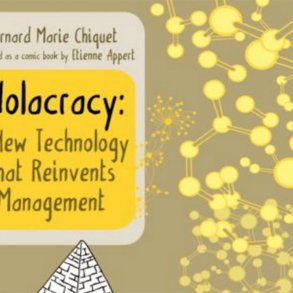How Holacracy® Differentiates the Organizational Roles from the People Doing Them
Do any of these symptoms show up in your organization?
- Lots of meetings with lots of discussion to reach consensus on things
- E-mails fly around with lots of people cc’d, often for unclear reasons
- People check-in with everyone before making decisions, and expect others will too
- People have lots of ideas about what “we” should do… but “we” doesn’t do it
These are all symptoms of lack of clarity, and many organizations suffer from them. When we’re not clear who needs to be involved in a decision or who has the authority to make it, we often default to getting everyone involved for lack of a better option. That at least allows a decision to get made (sometimes), and no one’s toes get stepped on (usually), though it sure has a price. It also points to a much deeper issue — a lack of clarity of what roles (not people) are needed given the organization’s purpose, what work each of those roles (not people) needs to do, and what authority each of those roles (not people) needs to do it.
Example Role Definition
Role: Marketing & PR
Purpose: Generate buzz about Holacracy
Scope: — Social networking & mailing list functions — Content & functionality of public website
Accountabilities: — Promoting & marketing trainings — Pursuing PR & speaking opportunities
The medicine for this fusion is organizational clarity — a defined structure for how the organization will pursue its purpose. This structure has nothing to do with the people, and it is best defined without reference to them — people come in later, to energize the Roles the organization needs to pursue its purpose. To define a Role without reference to the people, give the Role a descriptive name, and one or more related activities which the person filling the Role will energize for the organization. This Role-holder must have authority to execute upon and make decisions around those activities, and may also have defined limits of authority or constraints which ensure other Roles can do their work effectively as well. With Roles defined around what’s needed for the purpose, we can then look at our available talent and assign the best-fit to energize each Role — and most of us will fill multiple roles quite naturally. (Done well, this is quite different from a conventional job description exercise — more on that in a future post.)
Once we have this clarity — or better yet, a trusted process for continually generating this clarity over time — we can then find relief from the symptoms above. We no longer need meetings for everything, as we know exactly which other roles to involve in various activities and decisions. And when we do engage in a discussion we can do so without creating an expectation of consensus, because everyone is crystal clear on which role owns the decision. We no longer need to cc everyone on e-mails or check-in with everyone before making a decision, as we now know which roles should be involved in what and to what extent we should involve them… and just as important, to what extent we should just use our best judgment and make a decision autocratically. Organizational clarity frees us to be a good leader when we’re filling a role and need to balance input with expediency, and a good follower when another role owns a decision and shuts down discussion to make a judgment call.
So, how can you move towards this kind of organizational clarity? Here are a few of my techniques:
- When Seeking Consensus: When a discussion seems to be seeking consensus among the people about what decision to make, I ask “Is it clear what Role holds the authority to make this decision?”
- When Involving Everyone: When lots of people are pulled into a meeting (or e-mail chain), I ask “What Roles need to be involved and why?”
- When There’s Fusion: When a given human is habitually referenced by name as someone to check with or work with, especially if it’s a founder, I ask “What Role is it that needs to be consulted, and what Role is asking?”
These questions begin to highlight the lack of clarity and habitual fusion that necessarily exists in the early-stages of any effort — and often still exists quite a bit later, despite fancy job descriptions and org charts that pretend otherwise. And it is in answering these questions that something emerges beyond just the group of people — only then is a true organizationborn, as its own differentiated entity.
In Holacracy, generating this kind of grounded clarity happens through a defined governance process: each team holds regular governance meetings, which use Holacracy’s structured Integrative Decision-Making process to give everyone a voice and rapidly integrate needed perspectives. The output of that integrative process is clarity around Roles and their autocratic authorities, which are later assigned to team members to energize — thus moving from an unconscious fusion of the humans and their work to a clear differentiation and then conscious integration of “role and soul”.





“What roles are needed given the organisations purpose”. “A defined structure for how the organisation will pursue its purpose”. These quotes from the article show how roles are strictly tied to a defined purpose, which is separate from the people.
When the purpose of business is sustainable profitability, then clearly roles serve that function.
But when purpose is defined more generatively as ‘the benefit of all involved’, which I hope is the direction we are moving towards, then the division between roles and people is not so clear. Because then every voice counts, no-one can have authority over another, and purpose is not seen as something outside the people themselves.
Are these two purposes compatible? That is the question posed by a teal organisation. In our society the benefit of the individual is seen as depending on the survival of the organisation, since it provides an income. So the purposes are merged. However, in a society which provided a basic income to all citizens, such would not be the case.
It is my belief that these purposes are not compatible, and that is the struggle which is currently taking place in various forms in our society. This is the transition in which we are now involved, and where it is clear that the solutions given here would work for the present social structure, but not for the more generative ‘benefit of all involved’.
Hi Anna, thanks for your comment. The differentiation of role and soul is a very deep matter with complexities and nuances hard to grasp without a working knowledge of Holacracy. The default in Holacracy is we are people interacting in our work setting until we invoke or step under a role hat. We’re not role robots who have to step outside to be people. This is also what is meant by the Teal breakthrough of “wholeness,” showing up at work in our wholeness and being accepted there.
So yes, because in Teal indeed Evolutionary Purpose means “for the good of the evolution of humanity and the world” the division between roles and people is not so clear, AND it is worth making as a distinction, not a division. The advantages of making that distinction are probably not so apparent from outside a work setting in which the distinction is being made.
In Holacracy, every voice counts, perhaps even more so than before. But the way the voice is integrated dynamically into the work flow is different.
And that no one can have authority over another is the entire passionate purpose of Holacracy, the blood sweat and tears that went into designing and testing this system that prevents power-over in a systematic way. The SYSTEM prevents it.
And purpose is not seen as outside the people, but also not confined to the people. It is “here and beyond,” in a multi-dimensional kind of way that previously “purposes” were not conceived of.
Teal is by definition, as a stage of consciousness, entirely focused on generative “benefit of all involved.” Or it isn’t Teal. Period. That’s not to say any individual is entirely Teal or some other stage. But for the concept of Teal, that stage is dedicated to the good of all in ways actually unimaginable by less mature stages! Because it’s hard to imagine, it’s hard to explain.
Thanks again Anna!
Question: Can this stuff work for a 30 person department within an 1800 person organization?
A great and frequently asked question, Timothy! The answer is yes IF….. We probably have over 50 articles with stories about the situation you mentioned, but there is no good way to point to them all. I will post a link to one. You might also get onto the RO Discourse forum and ask there; I know Frederic Laloux gets this question ALL the time, and we’ve published several pieces in which he answers the question. It is probably also addressed in his new video series, Insights for the Journey. Best wishes on YOUR journey, and feel free to use our contact form so perhaps we can do some more customized networking for you! Here is the link to one article: https://enliveningedge.org/organizations/holacracy-experiment-washington-state-government/